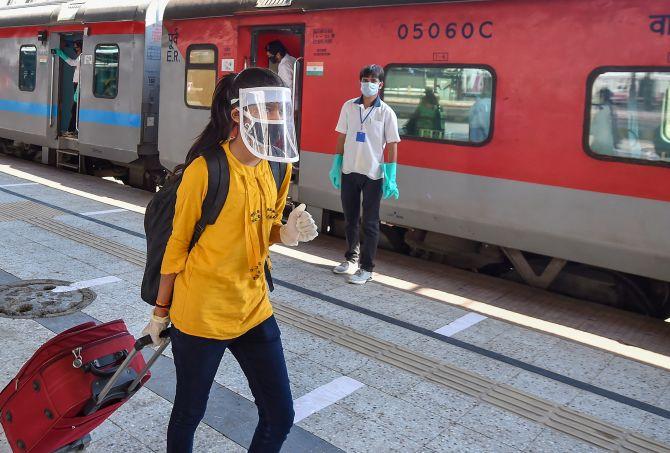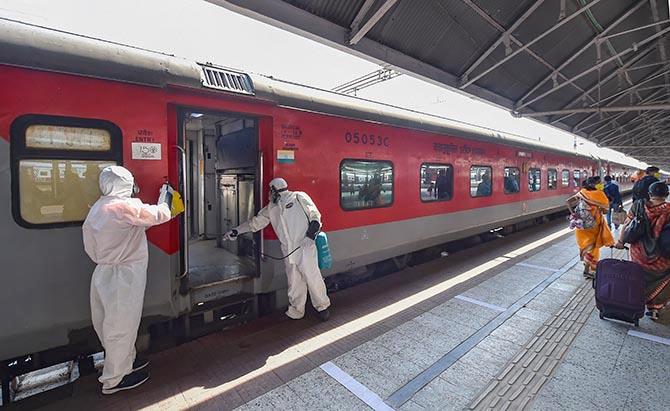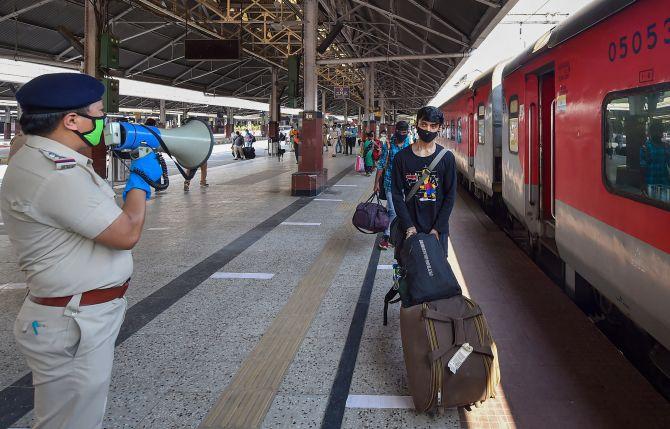 | « Back to article | Print this article |
When Finance Minister Nirmala Sitharaman tables her Budget on February 1, the numbers could be something to cheer.
Subhomoy Bhattacharjee reports.

The Indian Railways could show a better performance this year.
How? Because it hardly ran any passenger trains. If the social-distancing norms persist beyond March next year, the Railways could get positive net revenues in FY22, not one generated by suppressing costs.
However, the bad news is that even then the key performance metric of the Railways, the operating ratio (OR), a measure of how much it costs the organisation to earn a rupee (the percentage of working expenses to gross earnings), will not improve to less than 90 per cent.
Had it not been for the sunk costs, mostly salaries and pensions, which account for 65 per cent of its gross expenditure, the national transporter could have come out of the pandemic with a far improved balance sheet. The Railway Board has, however, been cagey.
In a reply to an RTI query, it has projected a possible loss of Rs 40,000 crore (Rs 400 billion), blaming it partially on the lack of passenger services.
However, passenger revenue is not even adequate to pay for itself and has to be subsidised by freight services. So a year spent without that subsidy is a good year for the Railways.
Appropriately enough, Railway Minister Piyush Goyal began a scheme last year to offer 151 passenger trains to be operated by the private sector.
The 2020 operation of the Railways gives an undiluted chance to observe what ails it and what doesn't.
Its unattractive accounts and the huge interlocking data have made it almost impossible to do this health check any other year. One of the best places then to begin the search is to examine its cash authorisations.

Passenger train services stopped with the lockdown in March and have not yet revived.
Against an average of daily 13,000 pairs of passenger trains the transporter ran before Covid arrived, it has run just 436 special trains, mostly Shramik Specials and 283 festival trains, up to the end of November and another 3,000-odd suburban trains.
The Railways was slated to earn Rs 61,000 crore (Rs 610 billion) from its passenger train services this year, and that's about 27 per cent of its receipts.
Till the end of September, it earned Rs 1,258.74 crore (Rs 12.58 billion). Even if movements rise in the second half of the year, the actuals will not cross Rs 10,000 crore (Rs 100 billion).
The near wipe-out of passenger earnings may seem a big hole in its finance, but it is not.
The passenger earnings are less than what the Railways earns from ferrying coal at Rs 67,355.22 crore (Rs 673 billion).
The enterprise would have been in a big hole if the coal business had stalled and the passenger business had run.
The Railways does not do cost estimates for its passenger trains and hence it is difficult to surmise how much the stoppage of each train will cost the organisation.
The Bibek Debroy-led panel did try to figure out such an exercise but could only do an illustrative study for six-odd Rajdhani and Shatabdi trains.
The data shows the Railways has hardly any variable cost. The statement of railway receipts and expenditure for 2020-2021 shows this clearly.
This financial year, for instance, it will spend Rs 34,720 crore (Rs 347 billion) as operating expenses on traffic services. It is a euphemism for salaries and office expenditure.
This should have been a variable cost, but the railway staff is permanent. Not even any travel allowance for them will be pruned.
Instead, savings shall occur in the Rs 60,623 crore (Rs 606 billion) it was to spend on the upkeep of its capital, the train tracks, locomotives, passenger cars, and even plant and equipment plus anything that moves on rail.
It costs a third to service wagons compared to a passenger carriage. The railway year book shows the operating cost of passenger coaches is 192.49 and that of wagons 58.72.
It costs Rs 2 to provide passenger services for every one rupee the Railways earns. When the trains are not running these costs do not appear.

There is a crude indicator to show that it is indeed happening. The monthly cash authorisation statement sent to every zone from the Railway Board is showing savings.
In November this year except expenditure on staff salary and pensions, spending on works has declined.
It was 16 per cent less at Rs 2,945 crore (rs 29.45 billion) compared with Rs 3,525 crore (Rs 35.25 billion) in November 2019. The trend has held up through this year.
The Railways will also save on fuel. Of the annual budget estimate of Rs 29,858 crore (Rs 298.58 billion), 70 per cent is for diesel, half of which is for passenger services. That saving is worth Rs 10,450 crore (Rs 104.50 billion).
Summing up, the Railways may not require under-providing for its pension liabilities as it did in FY21. The underfunding was crucial to help it show illusory net positive earnings of Rs 6,500 crore (Rs 65 billion) in FY21.
Minus the passenger business, the Rs 75,294.83 crore (Rs 752 billion) it has earned from its freight business in eight months of this financial year will cover more of its gross expenditure.
For the past three months this head is growing impressively at above the 9 per cent rate of growth estimated in the Budget.
It would have improved the OR of 96.2 per cent (97.4 per cent in FY20) down all the way to below the 90s, something that the transporter had never reached in more than a decade.
Yet when Union Finance Minister Nirmala Sitharaman tables her Budget on February 1, the numbers could be something to cheer.
Feature Presentation: Rajesh Alva/Rediff.com